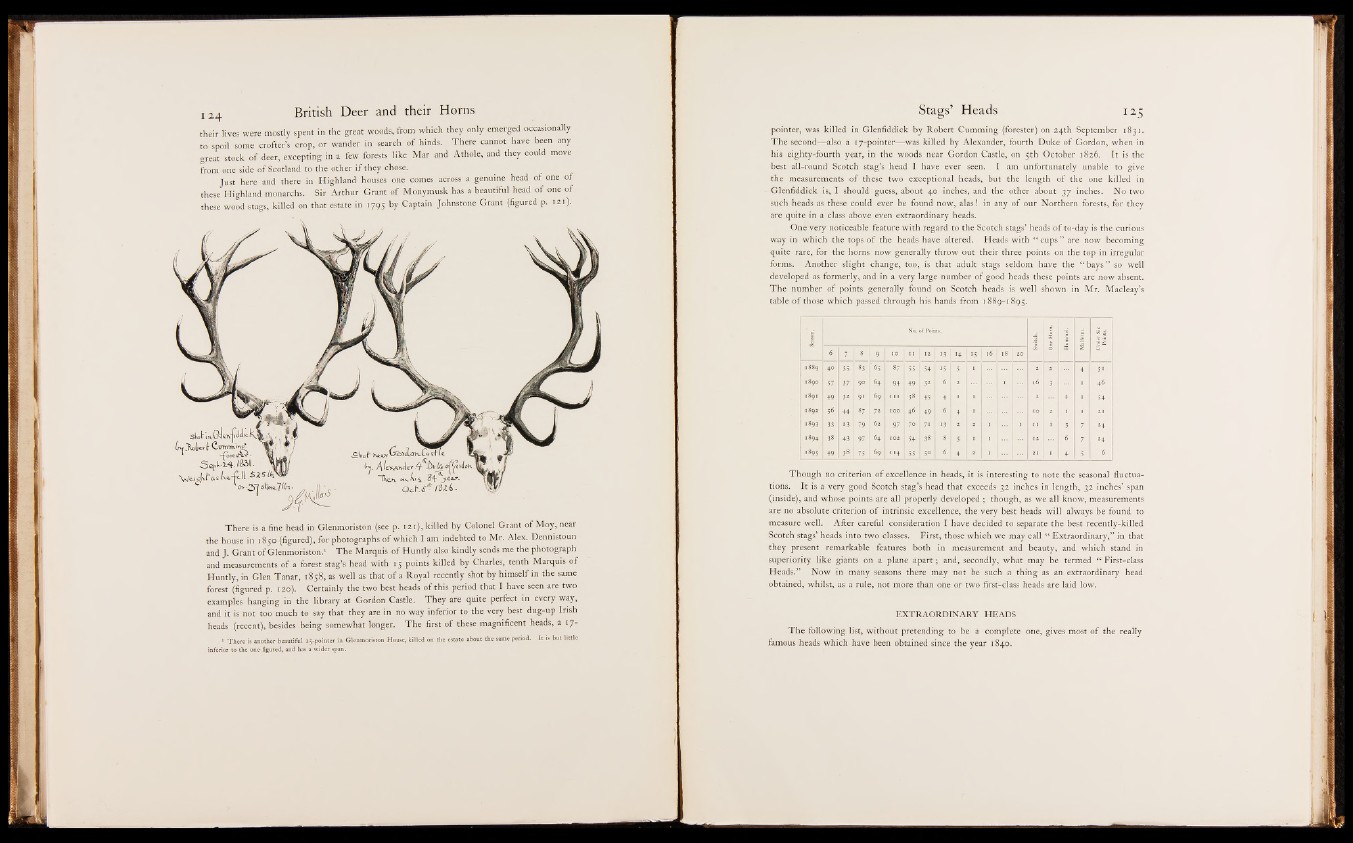
I
their lives were mostly spent in the great woods, from which they only emerged occasionally
to spoil some crofterfticrop, hr; wander in search o f hinds. There cannot have been any
great Stock o f deer, excepting in a few forests like Mar and Athole, and th e y | |u ld move
from one side o f Scotland to the other i f they chose. ; ■ i , '•
Just here and there in Highland houses one come» across a genuine head o f one of
these Highland monarchs. Sir Arthur Grant o f Monymusk has? a beautiful head o f one of
these wood-stags, killed on that estate in ig® by Captain Johnstone Grant (figured p. 121).
There is a fine head in Glenmoriston (see p. 121), killed by Colonel Grant o f M oy; near
the house in 1850 (figured), Tor photographs o f which X am indebted to Mr. Alex. Dennistoun
and J. Grant o f Glenmoristtli1 The Marquis o f H untly also kindly sehdkine the photograph
and measurements of a forest stag’s head with 15 points killed by Charles, tenth Marquis of
Huntly, in Glen Tanar, 1858, a? well as that o f a Royal recently shot by himself in the same
forest (figured p. i2 c |S Certainly the two best beads o f this period that I have seen are two
exampllt^hanging in the library at Gordon Castle. They are quite perfect in everyway,
and it is not too much to say that they are in no way inferior to the very best dug-up Irish
heads (recent), besides being Somewhat longer. The first o f these magnificent heads, a
1 There is another beautiful i ,-pointer in Glenmoriston House, killed on the estate abour the same period. It is but little
inferior to the one figured, and has a wider span.
:
pointer, was killed in Glenfiddick by Robert Cumming (forester) on 24th September 1831.
T h e second— also a 17-pointer— was killed by Alexander, fourth Duke o f Gordon, when in
his eighty-fourth year, in the woods near Gordon Castle, on 5th October 18-26. It is the
best all-round Scotch stag’s head I have ever seen. I am unfortunately unable to give
the measurements o f these two exceptional heads, but the length o f the one killed in
Glenfiddick is, I should guess, about 40 inches, and the other about 37 inches. No two
such heads as these could ever be found now, alas! in any o f our Northern forests, for they
are quite in a class above even extraordinary heads.
One very noticeable feature with regard to the Scotch stags’ heads o f to-day is the curious
way in which the tops o f the heads have altered. Heads with “ cups ” are now becoming
quite rare, for the horns now generally throw out their three points on the top in irregular
forms. Another slight change, too, is that adult stags seldom have the “ bays ” so well
developed as formerly, and in a very large number o f good heads these points are now absent.
T h e number of points generally found on Scotch heads is well shown in Mr. Macleay’s
table o f those which passed through his hands from 1889-1895.
|§i No. I p f i * Pi 1 .
6 7 8 9 H II 12 13 1 14 | 15 1 16 18 | y M O ,i'
1889 40 35 83 65 87 54 1$ 5 . . . . ... ... g * 4
1890 n 0 90 64 94 49 H I E ■ | .16 3 . 46
1891 49 32 9 1 69 I ., 38 45 4 » , ... ... ... I B 1 . 54 -
1892 56 44 87 7* B 46 49vt e 6 4 . ... ... ... HI . ■ 2.
1893 33 23 79 67. 97 H 7i^p3 1 2 n r ■ . . V rir1 24 1 189+ 38 43 97 64 IO. 54 3 8 1.' 8 5 . . ... ... ■ ■ ... 6 Q 24
189$ 49 38 is 69 " 4 - 5° 6 4 * - 21 1 4 -3V 6
Though no criterion o f excellence in heads, it is interesting to note the seasonal fluctuations.
It is a very good Scotch stag’s head that exceeds 32 inches in length, 32 inches’ span
(inside), and whose points are all properly developed ; though, as we all know, measurements
are no absolute criterion o f intrinsic excellence, the very best heads will always be found to
measure well. After careful consideration I have decided to separate the best recently-killed
Scotch stags’ heads into two classes. First, those which we may call “ Extraordinary,” in that
they present remarkable features both in measurement and beauty, and which stand in
superiority like giants on a plane apart; and, secondly, what may be termed “ First-class
Heads.” Now in many seasons there may not be such a thing as an extraordinary head
obtained, whilst, as a rule, not more than one or two first-class heads are laid low.
EXTRAORDINARY HEADS
The following list, without pretending to be a complete one, gives most o f the really
famous heads which have been obtained since the year 1840.